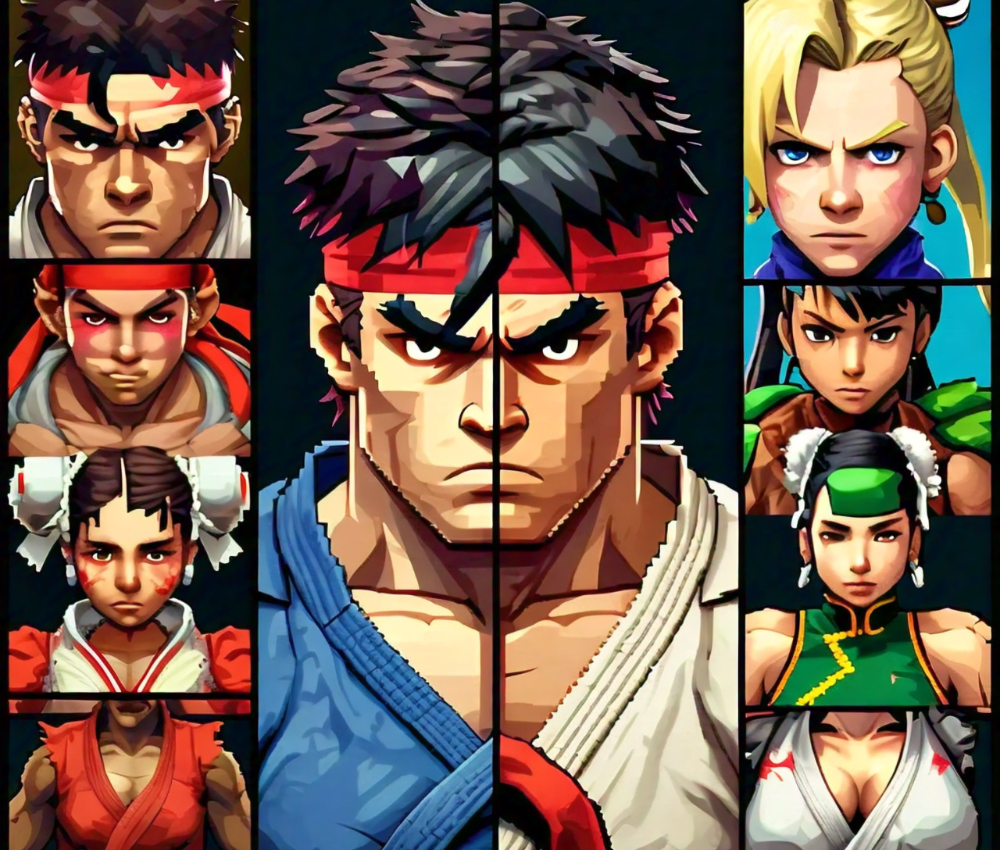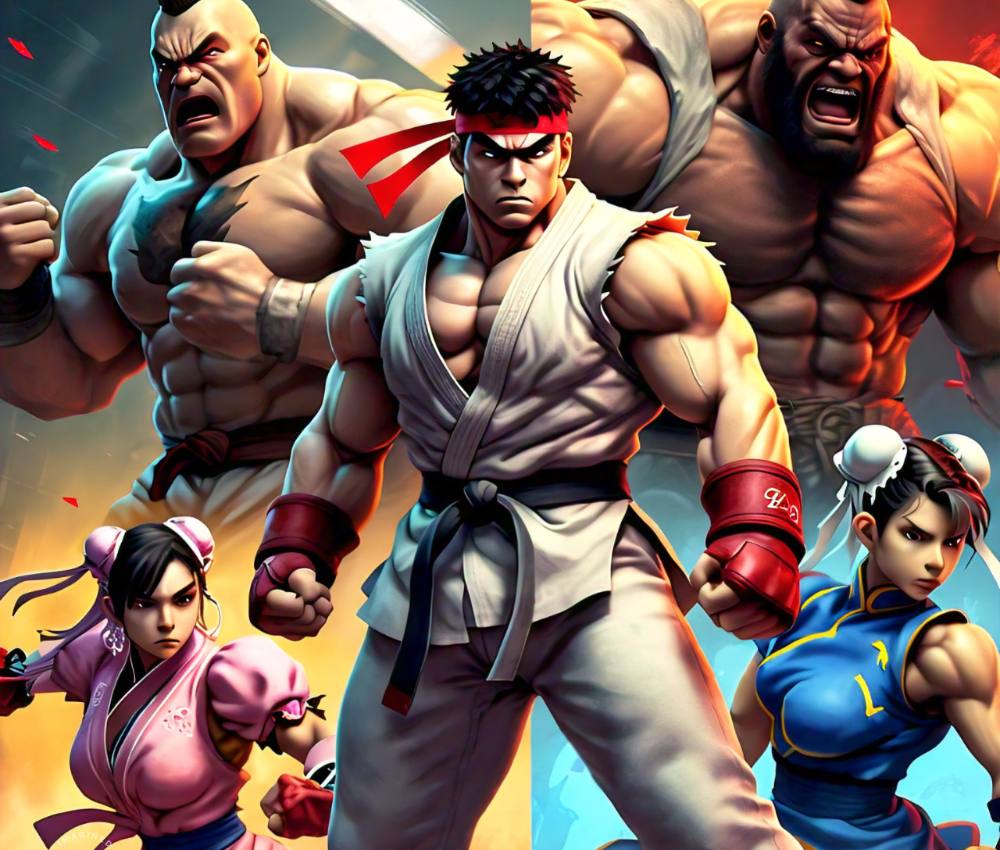The Street Fighter series has captivated gamers for over three decades, becoming a cornerstone of the fighting game genre. With its diverse cast of characters, each with a unique fighting style, backstory, and personality, Street Fighter has left an indelible mark on pop culture. But who have these characters inspired countless players and even shaped the way fighting games are designed? In this blog post, we’ll explore the Street Fighter characters in detail, delving into their origins, abilities, and the impact they’ve had on the series. We’ll also compare our analysis with other resources to ensure this post offers fresh insights and a more comprehensive understanding of the beloved roster.
The Birth of Street Fighter and Its Characters
When Street Fighter first hit the arcades in 1987, it introduced two characters: Ryu and Ken. With their simple yet effective moves, these two fighters laid the foundation for what would become a legendary series. However, it wasn’t until Street Fighter II in 1991 that the franchise took off, expanding the roster and introducing various characters that would become icons in their own right.
Ryu: The Eternal Wanderer
Ryu is the face of Street Fighter. As a wandering warrior, his journey is defined by his quest for self-improvement and true strength. His iconic white gi, red headband, and Hadouken move have become synonymous with the series. Ryu’s character is inspired by traditional martial arts protagonists, embodying the principles of discipline and perseverance. His story is one of constant growth as he seeks to overcome the “Satsui no Hado”—a dark power threatening to consume him.
Ken Masters: The American Martial Artist
Ken Masters, Ryu’s training partner and best friend, brings a contrasting personality to the series. While Ryu is stoic and severe, Ken is bold and confident. Hailing from a wealthy American family, Ken trained under the same master as Ryu, Gouken. His fighting style is similar to Ryu’s but with more flamboyance and flair. Ken’s character adds a layer of rivalry and camaraderie to the story, highlighting the balance between competition and friendship.
Chun-Li: The Strongest Woman in the World
Chun-Li is one of the most iconic female characters in video game history. Introduced in Street Fighter II, she is a Chinese Interpol officer seeking to avenge her father’s death at the hands of M. Bison, the series’ primary antagonist. With her qipao and spiked bracelets, Chun-Li’s design is feminine and fierce, symbolizing strength and determination. Her rapid-fire kicks and agility have made her a favourite among players, and her presence has paved the way for more strong female characters in gaming.
Guile: The American Soldier
Guile represents the archetype of the disciplined military man. With his distinct flattop hairstyle and dog tags, Guile is on a mission to take down M. Bison for the disappearance of his friend, Charlie Nash. Guile’s fighting style is based on actual military combat techniques, making him a unique character in the roster. His Sonic Boom and Flash Kick moves are signature attacks that emphasize his tactical approach to fighting.
M. Bison: The Tyrannical Dictator
M. Bison, also known as Vega in Japan, is the central villain of the Street Fighter series. As the leader of the criminal organization Shadaloo, Bison seeks world domination through the use of his psycho power. His character design, inspired by military dictators, exudes authority and menace. Bison’s role as the final boss in many Street Fighter games has solidified his status as one of the most memorable antagonists in gaming history.
The Expanding Roster: Characters That Shaped the Series

As the Street Fighter series evolved, so did its roster. Each new instalment introduced characters who brought fresh dynamics to the game regarding gameplay and story. Let’s explore some of the characters who have significantly impacted the series.
Akuma: The Embodiment of Dark Power
Akuma, also known as Gouki in Japan, is a character shrouded in mystery and fear. Introduced in Super Street Fighter II Turbo as a secret boss, Akuma is the brother of Ryu and Ken’s master, Gouken. Unlike his brother, Akuma has fully embraced the dark power of Satsui no Hado, making him one of the most powerful and feared characters in the series. His iconic “Raging Demon” move and relentless pursuit of strength have made him a fan favourite.
Sagat: The King of Muay Thai
Sagat, a towering Muay Thai fighter, is another iconic character in the Street Fighter series. Initially introduced as a boss character in the original Street Fighter, Sagat’s rivalry with Ryu is one of the most well-known in the series. Ryu’s victory over Sagat in the first game, leaving him with a prominent scar across his chest, fuels Sagat’s desire for revenge. However, as the series progresses, Sagat evolves from a vengeful antagonist to a more honourable warrior, seeking true strength rather than revenge.
Cammy: The Shadaloo Assassin Turned Hero
Cammy, first introduced in Super Street Fighter II, is a British special forces operative with a mysterious past. Initially a brainwashed assassin working for M. Bison, Cammy eventually breaks free from his control and becomes a key member of the good guys. Her character design, with her signature green leotard and military beret, is distinctive and practical, reflecting her military background. Cammy’s agility and quick strikes make her a popular choice among players.
Dhalsim: The Yoga Master
Dhalsim is one of the most unique characters in the Street Fighter roster. A pacifist yoga master from India, Dhalsim fights to provide for his village and protect the innocent. His long limbs, fire-breathing abilities, and teleportation moves set him apart from the rest of the cast. Dhalsim’s character is a blend of mysticism and spirituality, with his abilities reflecting the influence of Indian culture and philosophy.
Zangief: The Red Cyclone
Zangief, also known as the “Red Cyclone,” is a professional wrestler from Russia. His massive build and wrestling moves make him a formidable opponent in close combat. Zangief’s character design is inspired by real-life wrestlers, with his signature spinning piledriver move being a highlight of his arsenal. Despite his rough appearance, Zangief is portrayed as a patriotic and honourable fighter, representing the strength of his homeland.
The Evolution of Street Fighter Characters: From Pixels to Icons

Over the years, the Street Fighter characters have undergone significant changes in design, backstory, and gameplay mechanics. These changes reflect advancements in technology and shifts in cultural trends and player preferences.
From 2D Sprites to 3D Models
The original Street Fighter characters were rendered as 2D sprites, which, while limited in detail, were highly expressive and conveyed a lot of personality through their animations. As technology advanced, the series transitioned to 3D models with Street Fighter IV, allowing for more detailed character designs and fluid animations. This shift also enabled the developers to add more depth to the characters’ appearances, making them more lifelike and relatable.
Deepening Backstories and Relationships
As the series progressed, the backstories and relationships between characters became more complex. The rivalry between Ryu and Ken, the hostility between Chun-Li and M. Bison, and Cammy’s complicated history all add layers to the narrative, making the characters more than just fighters—they are individuals with motivations, fears, and desires. These elements have been expanded upon in various spin-offs, comics, and animated adaptations, further enriching the lore of the Street Fighter universe.
The Influence of Cultural Trends
The design of Street Fighter characters has always been influenced by cultural trends. For example, characters like Dee Jay, a Jamaican kickboxer, and T. Hawk, a Native American warrior, reflect the global appeal of the series and Capcom’s efforts to create a diverse cast. However, some characters have also been controversial, with accusations of cultural appropriation and stereotyping. Over time, the developers have tried to address these issues, refining character designs and backstories to be more respectful and accurate.
The Legacy of Street Fighter Characters
The legacy of Street Fighter characters extends beyond the games themselves. These characters have become cultural icons, appearing in movies, TV shows, comics, and even influencing other video games. Their moves and catchphrases have entered the lexicon of pop culture, and their impact can be seen in the countless tributes, fan art, and cosplay dedicated to them.
Street Fighter in Competitive Gaming
The Street Fighter characters have also played a crucial role in developing the competitive gaming scene. Characters like Ryu, Ken, and Chun-Li are staples in fighting game tournaments, with players mastering their moves and strategies to compete at the highest level. The depth and balance of the Street Fighter roster have made it a favourite among esports athletes, contributing to the growth of the fighting game community.
Influence on Other Fighting Games
The success of Street Fighter and its characters has inspired numerous other fighting games. Franchises like Mortal Kombat, Tekken, and King of Fighters have all drawn inspiration from Street Fighter‘s character design, mechanics, and storytelling. The archetypes established by Street Fighter—the stoic hero,
Read more on Cp24.
